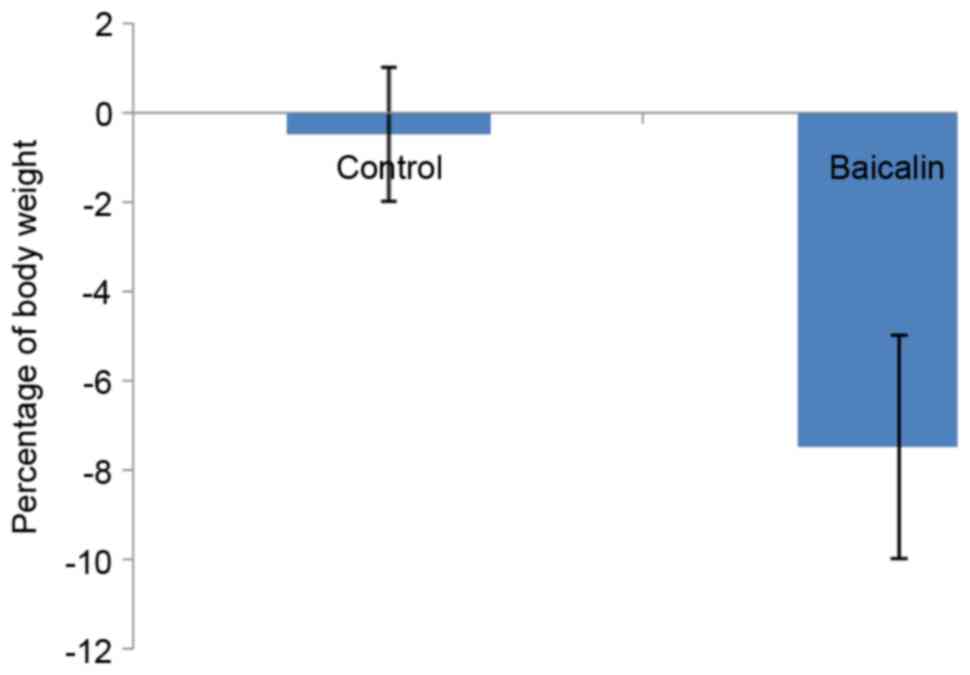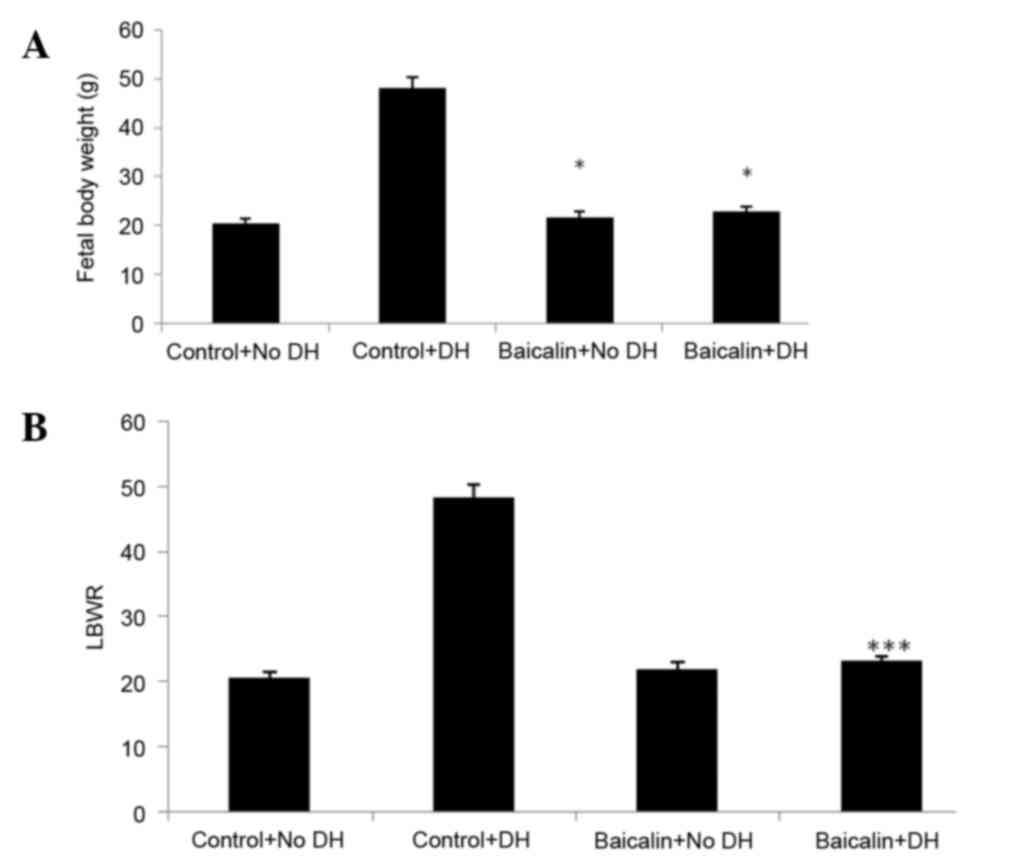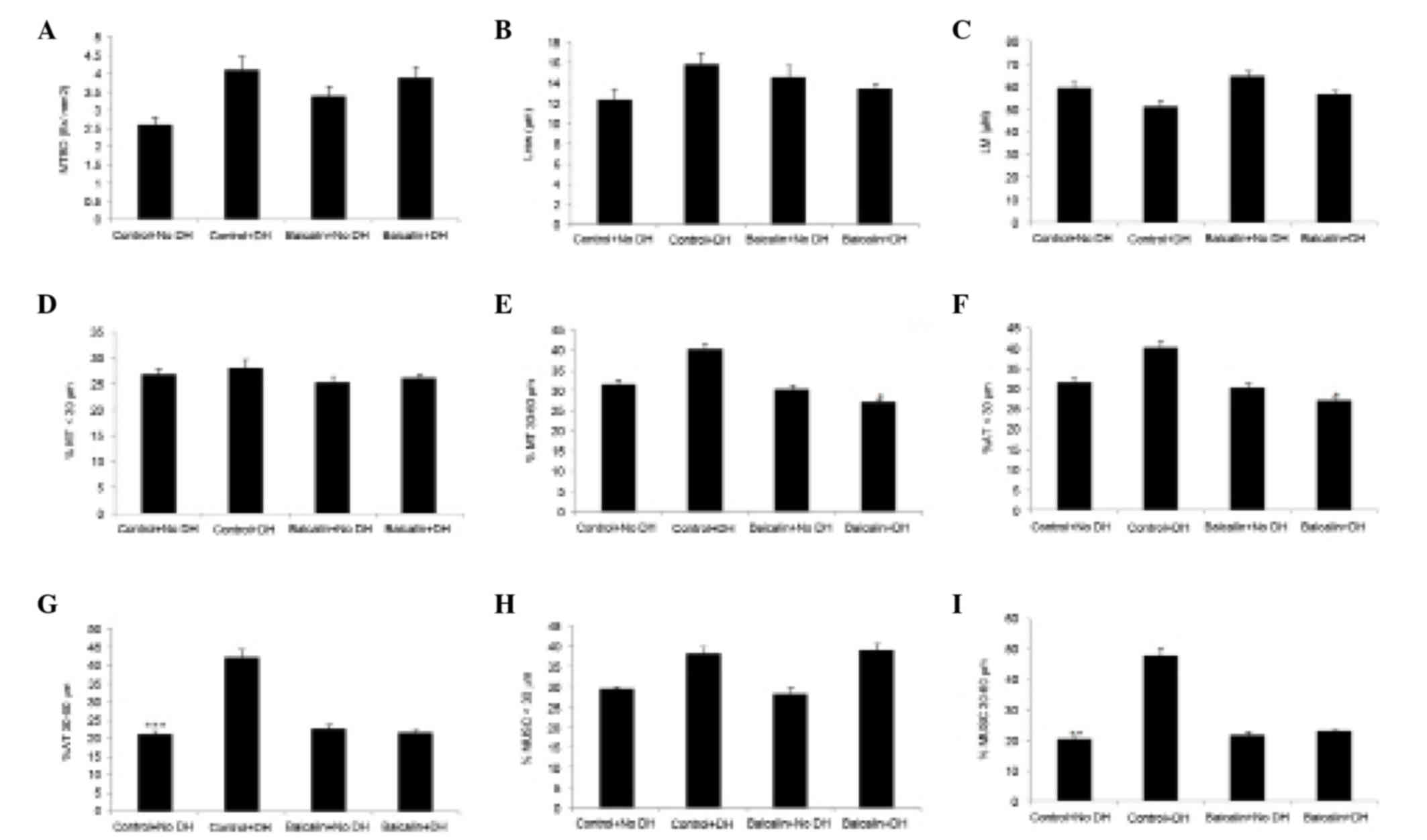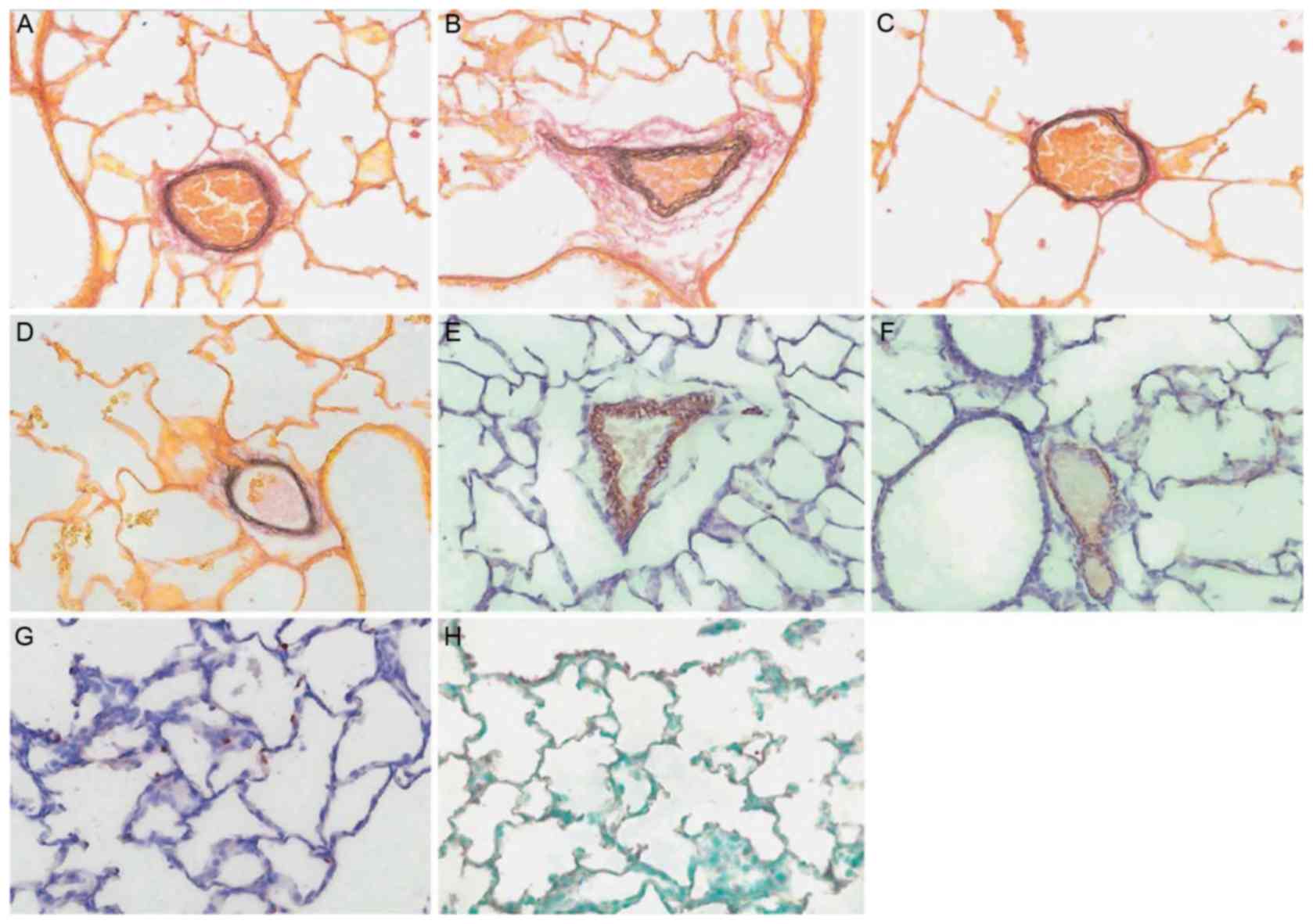Protective effect of baicalin on fetal lung development in a rabbit model of congenital diaphragmatic hernia
- Authors:
- Published online on: October 31, 2017 https://doi.org/10.3892/etm.2017.5409
- Pages: 61-66
-
Copyright: © Su et al. This is an open access article distributed under the terms of Creative Commons Attribution License.
Abstract
Introduction
Congenital diaphragmatic hernia (DH) is a birth defect of the diaphragm is known that is exhibited in 1/3,000 live births worldwide (1). In DH cases, ~85% exhibit the left-sided posterolateral defect, 40% of whom exhibited an isolated defect (2). DH is lethal in ~35% of cases in the neonatal period and surviving patients suffer from a number of resulting chronic disorders such as decreased respiratory function and asthma (3). Furthermore, in patients with DH, lung development is altered, which may lead to medial hyperplasia, decreased pulmonary vessels displaying adventitial thickening, reduced surface area for gas exchange, an increase in the thickness of alveolar walls and a decrease in the number of bronchial branches (4). At present, effective management of DH is limited and highly specialized equipped center is required for fetal endoscopic tracheal occlusion. In fetal endoscopic tracheal occlusion, a detachable endoluminal balloon is inserted endoscopically and subsequently changes shape to provide effective occlusion of the growing trachea without causing tracheal damage (5). Furthermore, management of pulmonary hypoplasia is achieved through transplacental or intra-amniotic injection of several agents with pulmonary delivery facilitated by fetal breathing movements rather than fetal tracheal instrumentation (6–7). A number of drugs, including tetrandrine, estrogen, ghreline, sildenafil and tadalafil, have previously been used in animal models to explore the treatment of DH (8). However, in the clinical application of these drugs, the results of these preclinical experiments have not been replicated.
Baicalin is a glycoside that is isolated from the leaves of Scutellaria galericulata, and is reported to exert anti-anxiety actions by acting on the GABA receptor without producing sedation (9). Furthermore, baicalin exerts an inhibitory effect on prolyl endopeptidase and has been demonstrated to effectively manage pancreatic cancer by inducing apoptosis (10–11). In addition, a previous study on baicalin has suggested that it improves the fetal lung growth by increasing fetal lung surfactant phospholipids (12). Given these previous findings, the aim of the present study was to evaluate the effect of baicalin on fetal lung development in DH.
Materials and methods
Animals
Female New Zealand rabbits (3–4 kg; 9–12 months old) were used in the present study and male New Zealand rabbits were also procured from Shanghai Institutes for Biological Sciences, Shanghai, China). Rabbits (n=12) were housed in standard laboratory conditions, including a 12-h light-dark cycle and at room temperature 20–25°C. Rabbits were acclimatized to these conditions for 10 days prior to the onset of experiments. All the protocols used in the present study were approved by the Animal Ethics Committee of Yantai Yuhuangding Hospital of Qingdao University (Yantai, China).
Experimental procedure
Rabbits were acclimatized in the animal house for 10 days and later housed individually following mating in the conditions detailed above with ad libitum access to water and chow. Blood glucose level and body weight of each rabbit was measured prior to gestational day (GD) 23 using a GOD-POD kit (Accuplex Diagnostics Ltd., Maynooth, Ireland). Rabbits were anesthetized by administering ketamine (35 mg/kg; Dechra, Northwich, UK) and xylazine (6 mg/kg) intramuscularly (Shenzhen Sendi Biotechnology Co., Ltd., Guangdong, China). Buprenorphine (0.03 mg/kg; BioDelivery Sciences International, Inc., Raleigh, NC, USA), medroxyprogesterone (0.9 mg/kg; Pfizer, New York, NY, USA) and penicillin G (300,000 U; Hebei New Century Pharmaceutical Co., Ltd., Hebei, China) were administered subcutaneously and 1.5% isoflurane (Sigma-Aldrich; Merck KGaA, Darmstadt, Germany) was used with oxygen (2 ml/min) to maintain anesthesia. The surgical area (abdomen) was subsequently shaved and sterile conditions were maintained for all surgical procedures. Lidocaine (Xylocaine; Astra Zeneca, Cambridge, UK) at a concentration of 1% was administered to the subcutaneous tissue prior to surgery. Laparotomy was performed to exteriorized uterine horns according to a previous study (13), thus establishing a left-sided diaphragmatic hernia in one additional fetus and in two ovarian ends. Briefly, a purse string suture (6-0 Prolene) was inserted, and the left fetal arm was exteriorized. The diaphragm was exposed through a low left lateral thoracotomy using purpose-designed retractors and the membraneous part was opened with scissors. The uterus was protected from dehydration and hypothermia via regular washing with warm saline throughout the surgical procedure. Subsequently, a 2-0 polyglactine suture and a 2-0 nylon were used to close the rectus fascia and the skin, respectively.
Baicalin administration and tissue collection
Rabbits were separated randomnly into two groups (n=6) on GD24. The control group was administered an equal volume of saline solution and the baicalin-treated group were administered 5 mg/kg/day baicalin (Sigma-Aldrich; Merck KGaA) for one week, i.e. until the GD31. For each case, one surviving littermate acted as an internal nonhypoplastic control. Therefore, fetuses used in the present study were separated into the following four groups (n=7): Control with DH, control without DH, baicalin with DH and baicalin without DH.
One day following the end of treatment, weight and blood glucose was measured and rabbits were subsequently anesthetized using ketamine and xylazine as described above. Confirmation of fetus viability was performed at cesarean section and later rabbits were sacrificed by administering 1 ml otetracaine (5 mg), mebezonium (50 mg) and embutramide mixture (200 mg; all Marion Roussel, Brussels, Belgium) intravenously on gestational day 31. Fetuses were collected and anesthetized via intraperitoneal injection of ketamine (50 mg/kg) and blood was collected via cardiac puncture. Fetuses were sacrificed using the same method as mothers. The weight of fetuses was subsequently measured, lungs were isolated and weighed and lung-to-body weight ratios (LBWRs) were calculated. The lung contralateral to the diaphragmatic defect was ligated at the hilum, snap frozen in liquid nitrogen and stored at −80°C. The trachea was cannulated and the left lung (ipsilateral) was perfused with 10% formalin under 25 cm H2O pressure for 1 day at room temperature and embedded in paraffin.
Lung morphometry
Paraffin-embedded lung tissues were cut into 4-µm thick sections and stained at room temperature for 10 min with hematoxylin and eosin. Sections were observed using a trinaocular light microscope (Zeiss AG, Oberkochen, Germany) at ×200 magnification for the microscopic evaluation of lung tissue. Each fetal lung tissue sample was separated into 20 equal and non-overlapping areas. Mean terminal bronchial density (MTBD) is inversely proportional to the number of alveoli present in each bronchiole, mean wall transection length (Lmw; an index of the thickness of alveolar septa) and mean linear intercept (Lm), which is associated with airspace size. Furthermore, vascular morphometry was observed by staining lung tissues with Miller's elastic stain and viewing under light microscopy at ×400 magnification. Lung morphology was evaluated by measuring the external (ED), internal (ID) and adventitial (AD) diameter along the shortest axis. Medial thickness and adventitial thickness were calculated by using these parameters and the following formulae: Percentage medial thickness (%MT) = ED-ID / ED ×100.Percentage adventitial thickness (%AT) = AD-ED / ED ×100.Peripheral muscularization was determined as previously described (14).
Immunohistochemistry
Histological study of lung tissue was performed by cutting 4 µm sections of lung tissue and staining them with anti-α-smooth muscle actin (SMA), -Ki-67 and -surfactant protein B (SPB) antibodies (Santa Cruz Biotechnology, Inc., Dallas, TX, USA). Endogenous peroxidase was blocked using 0.5% H2O2 in methanol for Ki67 staining and α-SMA staining for 30 min at room temperature. Deparaffinized tissue sections were incubated at 37°C with mouse polyclonal anti-SPB (1:75) (sc-7702) and human monoclonal anti-Ki-67 antibodies (1:50) (sc-3752; both Santa Cruz Biotechnology, Inc.) at 4°C, and human monoclonal anti-α-SMA (1:200) (sc-4961; Santa Cruz Biotechnology, Inc.) antibodies at 27°C for 2 h. Sections (n=6) used for Ki-67 staining were washed with TBS/Tween-20 (0.1%) and incubated with rabbit serum, anti-mouse peroxidase (1:100; X-5832; Jackson ImmunoResearch Europe, Ltd., Newmarket, UK) and 3,3′-Diaminobenzidine (DAB) for 10 min at 37°C. Subsequently, tissues were counterstained with hematoxylin for 30 min at room temprature, dehydrated for 10 min with ethanol and mounted. SPB staining tissues (n=7) were incubated with rabbit serum and biotin-conjugated anti-goat secondary antibody (1:250; sc-2489; Santa Cruz Biotechnology, Inc.) for 30 min at 37°C, washed in PBS and incubated for 20 min at 37°C with streptavidin alkaline phosphatase conjugate (1:1,000; Roche Diagnostics, Basel, Switzerland). Samples were then washed again, counterstained for 2 min with nitro blue tetrazolium and methyl green at room temperature and mounted. Sections used for α-SMA staining (n=7) were incubated with anti-mouse horseradish peroxidase-conjugated antibody (1:100; Jackson ImmunoResearch) and rabbit serum for 20 min at 37°C. Sections were subsequently washed with PBS and incubated with DAB for 10 min at 37°C. Hematoxylin was used to counterstain sections for 10 min at room temperature, which were then mounted. ImageJ software (v1.47, National Institutes of Health, Bethesda, MD, USA) was used for evaluation. Slides were observed with a light microscope (Zeiss AG) at ×400 magnification to record 10 non-overlapping images in each slide. The number of Ki-67-positive cells were counted and Ki-67 density percentage was measured. For SPB staining, 10 non-overlapping images were also captured at ×400 magnification and the number of SPB stained cells present per mm2 of total tissue was calculated (%).
Statistical analysis
Data are presented as the mean ± standard deviation (n=7). Results were analyzed statistically via one-way analysis of variance with a post hoc Dunnett test. P<0.05 was considered to indicate a statistically significant difference.
Results
Fetal survival
Effects of baicalin treatment on the survival of fetuses are presented in Table I. In the present study 17 rabbits were used, 1 of which developed incisional hernia and another exhibited chronioamnionitis at fetal collection. Of the remaining 15, 6 rabbits, which produced 56 fetuses, were administered saline and considered as controls, and the remaining 9, which produced 84 fetuses, were administered baicalin. Of the total 140 fetuses, DH was developed in 48 fetuses, ~34%.
Effect of baicalin on weight loss in mother rabbits
The effect of baicalin treatment on the percentage of weight loss in mother rabbits is presented in Fig. 1. It was observed that treatment with baicalin markedly increased the percentage of weight loss to 7.4%, compared with 0.25% observed in the control group, during the period of GD23-GD31.
Effect of baicalin on fetal body weight and LBWR
A significant decrease was observed in the body weight of fetuses in both baicalin groups compared with control groups (Fig. 2A). LBWR was found to be significantly decreased in the baicalin with DH group compared with the control with DH group. However there was no significant difference between the LBWR of the control without DH and baicalin without DH groups (Fig. 2B).
Effect of baicalin on lung morphometry
Effects of baicalin on lung morphometry in the rabbit model of DH are presented in Fig. 3. Significant differences were observed in the airway morphometry of DH groups. It was observed that in control groups, MTBD and Lmw were markedly increased with DH, which was not observed in baicalin treated groups. However, no significant changes in Lm were observed between any groups. Marked changes in the %MT were observed in 30–60 µm vessel size and not in <30 µm. It was also observed that %AT <30 and %MT 30–60 µm were significantly decreased in the baicalin with DH compared with the control with DH group.
There were no significant changes observed in the muscularization of vessels <30 µm in the baicalin with DH groupcompared with the control group. However, treatment with baicalin markedly decreased the muscularization of vessels in the 30–60 µm category in DH groups.
Effect of baicalin on the expressions of Ki-67 and SPB
Treatment with baicalin was demonstrated to markedly enhance the expression of Ki-67 in lungs compared with control groups. However there was no significant difference observed between the expression of SPB in the lungs of the baicalin treated and control groups (Table II). As presented in Fig. 4, no marked differences in SPB was observed between any groups and Ki-67 stain shows positive nuclear stain in brown (Fig. 4G). A representative stain of SPB with positive brown protein coating the alveolar wall is also presented.
Discussion
Baicalin is a naturally isolated glycoside that is reported to increase fetal lung surfactant phospholipids and thereby enhance lung growth in fetal development (12). Furthermore, it also exhibits anti-inflammatory, antiviral, anticancer and analgesic effects, as documented previously (15–16). Baicalin significantly protects against lipopolysaccharide induced lung injury as it exhibits anti-inflammatory actions by blocking the communication between the CX3CL1-CX3CR1 axis and the nuclear factor-κB signaling pathway (17). Furthermore, it protects against lung injury via its antiviral activity (18). Therefore, the aim of the present study was to evaluate the effect of baicalin treatment on fetal lung development in a rabbit model of DH. The effects of baicalin were evaluated by determining fetal LBWR, lung morphometry analysis and immunohistochemistry of lung tissue via α-SMA, Ki-67 and SPB staining.
In the present study, baicalin administration in mother rabbits induced no significant effect in the morphologic, anatomic and proliferation indices following surgically-induced DH. A recent study suggested that DH was associated with significant loss of body weight of mother and fetus, increased fetal mortality rates (19). The findings of the present study demonstrated that maternal and fetal weight loss and mortality was higher. However LBWR was demonstrated to be significantly decreased in the baicalin-treated DH group compared with the control + DH group.
In a previous study, baicalin treatment was demonstrated to improve lung development in fetal rats by increasing pulmonary surfactant phospholipids (12). Baicalin was also reported to improve the level of growth hormone in the mother, which may have also improved fetal lung development (12). However, a previous study on DH demonstrated that ghrelin, which is a physiologic growth hormone, significantly improved lung development in neonates (20). However, the failure to demonstrate an improvement in airway morphometry may be due to differences in the model, particularly in the stages of lung development. Lung hypoplasia in the nitrofen rat model represents an embryonic defect in lung development, and this animal is also born in the late canalicular or early saccular phase (20). Conversely, rabbits are in the late pseudoglandular phase at the time of surgically-induced DH, yet the final three stages of lung development occur rapidly in utero. Transplacental treatment in the rat model was administered in the mid-pseudoglandular or early saccular phase of lung development, whereas in the rabbit it occurred in the early canalicular and alveolar phase (21). Regardless, clinical treatment may only be initiated following the time of diagnosis, which is typically following 20 weeks' gestation, hence in the canalicular stage of lung development, thus the rabbit is a more representative model (22).
Lung maturity of lung is recognized by the enhanced expression of SPB (23) and the present results did not reveal any significant change in SPB expression in the baicalin with DH group. Furthermore, Ki-67 is a marker of lung proliferation (17) and no significant changes in Ki-67 expression were observed following baicalin treatment.
The present study investigated the treatment of defect in lung development in large animals via a natural, non-invasive fetal therapy. Large animals like rabbit exhibit the same pattern of lung development as humans (24). Furthermore, the present study avoided the use of invasive therapies that are responsible for infection, preterm labor and premature rupture of membrane. However, the present study tested the highest-tolerated dose that is effective in lung development by enhancing the surfactant.
In conclusion, the present study suggests that baicalin was able to improved lung morphology in rabbits. However, due to limited effects in airways, the present study concludes that baicalin is not suitable for the management of DH.
References
|
Clark RH, Hardin WD Jr, Hirschl RB, Jaksic T, Lally KP, Langham MR Jr and Wilson JM: Current surgical management of congenital diaphragmatic hernia: A report from the congenital diaphragmatic hernia study group. J Pediatr Surg. 33:1004–1009. 1998. View Article : Google Scholar : PubMed/NCBI | |
|
Stoll C, Alembik Y, Dott B and Roth MP: Associated malformations in cases with congenital diaphragmatic hernia. Genet Couns. 19:331–339. 2008.PubMed/NCBI | |
|
Tsao K and Lally KP: The congenital diaphragmatic hernia study group: A voluntary international registry. Semin Pediatr Surg. 17:90–97. 2008. View Article : Google Scholar : PubMed/NCBI | |
|
Verbelen T, Lerut T, Coosemans W, De Leyn P, Nafteux P, Van Raemdonck D, Deprest J and Decaluwé H: Antireflux surgery after congenital diaphragmatic hernia repair: A plea for a tailored approach. Eur J Cardiothorac Surg. 44:263–268. 2013. View Article : Google Scholar : PubMed/NCBI | |
|
Dekoninck P, Gratacos E, Van Mieghem T, Richter J, Lewi P, Ancel AM, Allegaert K, Nicolaides K and Deprest J: Results of fetal endoscopic tracheal occlusion for congenital diaphragmatic hernia and the set up of the randomized controlled TOTAL trial. Early Hum Dev. 87:619–624. 2011. View Article : Google Scholar : PubMed/NCBI | |
|
Trudinger BJ and Knight PC: Fetal age and patterns of human fetal breathing movements. Am J Obstet Gynecol. 137:724–728. 1980. View Article : Google Scholar : PubMed/NCBI | |
|
Davey MG, Danzer E, Schwarz U, Robinson L, Shegu S, Adzick NS, Flake AW and Hedrick HL: Prenatal glucocorticoids improve lung morphology and partially restores surfactant mRNA expression in lambs with diaphragmatic hernia undergoing fetal tracheal occlusion. Pediatr Pulmonol. 41:1188–1196. 2006. View Article : Google Scholar : PubMed/NCBI | |
|
Lewis NA, Holm BA, Rossman J, Swartz D and Glick PL: Late administration of antenatal vitamin A promotes pulmonary structural maturation and improves ventilation in the lamb model of congenital diaphragmatic hernia. Pediatr Surg Int. 27:119–124. 2011. View Article : Google Scholar : PubMed/NCBI | |
|
Li BQ, Fu T, Gong WH, Dunlop N, Kung H, Yan Y, Kang J and Wang JM: The flavonoid baicalin exhibits anti-inflammatory activity by binding to chemokines. Immunopharmacology. 49:295–306. 2000. View Article : Google Scholar : PubMed/NCBI | |
|
Tarragó T, Kichik N, Claasen B, Prades R, Teixidó M and Giralt E: Baicalin, a prodrug able to reach the CNS, is a prolyl oligopeptidase inhibitor. Bioorg Med Chem. 16:7516–7524. 2008. View Article : Google Scholar : PubMed/NCBI | |
|
Shieh DE, Cheng HY, Yen MH, Chiang LC and Lin CC: Baicalin-induced apoptosis is mediated by Bcl-2-dependent, but not p53-dependent, pathway in human leukemia cell lines. Am J Chin Med. 34:245–261. 2006. View Article : Google Scholar : PubMed/NCBI | |
|
Chen CM, Wang LF and Cheng KT: Maternal baicalin treatment increases fetal lung surfactant phospholipids in rats. Evid Based Complement Alternat Med. 2011:4087142011. View Article : Google Scholar : PubMed/NCBI | |
|
Wu J, Yamamoto H, Gratacos E, Ge X, Verbeken E, Sueishi K, Hashimoto S, Vanamo K, Lerut T and Deprest J: Lung development following diaphragmatic hernia in the fetal rabbit. Human Reprod. 15:2483–2488. 2000. View Article : Google Scholar | |
|
Hattori Y, Jojima T, Tomizawa A, Satoh H, Hattori S, Kasai K and Hayashi T: A glucagon-like peptide-1 (GLP-1) analogue, liraglutide, upregulates nitric oxide production and exerts anti-inflammatory action in endothelial cells. Diabetologia. 53:2256–2263. 2010. View Article : Google Scholar : PubMed/NCBI | |
|
Middleton E Jr, Kandaswami C and Theoharides TC: The effects of plant flavonoids on mammalian cells: Implications for inflammation, heart disease, and cancer. Pharmacol Rev. 52:673–751. 2000.PubMed/NCBI | |
|
Bonham M, Posakony J, Coleman I, Montgomery B, Simon J and Nelson PS: Characterization of chemical constituents in Scutellaria baicalensis with antiandrogenic and growth-inhibitory activities toward prostate carcinoma. Clin Cancer Res. 11:3905–3914. 2005. View Article : Google Scholar : PubMed/NCBI | |
|
Huang KL, Chen CS, Hsu CW, Li MH, Chang H, Tsai SH and Chu SJ: Therapeutic effects of baicalin on lipopolysaccharide-induced acute lung injury in rats. Am J Chin Med. 36:301–311. 2008. View Article : Google Scholar : PubMed/NCBI | |
|
Eastwood MP, Kampmeijer A, Jimenez J, Zia S, Vanbree R, Verbist G, Toelen J and Deprest JA: The effect of transplacental administration of glucagon-like peptide-1 on fetal lung development in the rabbit model of congenital diaphragmatic hernia. Fetal Diagn Ther. 39:125–133. 2016. View Article : Google Scholar : PubMed/NCBI | |
|
Santos M, Bastos P, Gonzaga S, Roriz JM, Baptista MJ, Nogueira-Silva C, Melo-Rocha G, Henriques-Coelho T, Roncon-Albuquerque R Jr, Leite-Moreira AF, et al: Ghrelin expression in human and rat fetal lungs and the effect of ghrelin administration in nitrofen-induced congenital diaphragmatic hernia. Pediatr Res. 59:531–537. 2006. View Article : Google Scholar : PubMed/NCBI | |
|
Keijzer R, Liu J, Deimling J, Tibboel D and Post M: Dual-hit hypothesis explains pulmonary hypoplasia in the nitrofen model of congenital diaphragmatic hernia. Am J Pathol. 156:1299–1306. 2000. View Article : Google Scholar : PubMed/NCBI | |
|
Garne E, Haeusler M, Barisic I, Gjergja R, Stoll C and Clementi M; Euroscan Study Group, : Congenital diaphragmatic hernia: Evaluation of prenatal diagnosis in 20 European regions. Ultrasound Obstet Gynecol. 19:329–333. 2002. View Article : Google Scholar : PubMed/NCBI | |
|
Romaní-Pérez M, Outeiriño-Iglesias V, Gil-Lozano M, González-Matías LC, Mallo F and Vigo E: Pulmonary GLP-1 receptor increases at birth and exogenous GLP-1 receptor agonists augmented surfactant-protein levels in litters from normal and nitrofen-treated pregnant rats. Endocrinology. 154:1144–1155. 2013. View Article : Google Scholar : PubMed/NCBI | |
|
Mendelson CR and Boggaram V: Hormonal and developmental regulation of pulmonary surfactant synthesis in fetal lung. Baillieres Clin Endocrinol Metab. 4:351–378. 1990. View Article : Google Scholar : PubMed/NCBI | |
|
Kamaruzaman NA, Kardia E, Kamaldin N', Latahir AZ and Yahaya BH: The rabbit as a model for studying lung disease and stem cell therapy. Biomed Res Int. 2013:6918302013. View Article : Google Scholar : PubMed/NCBI |













